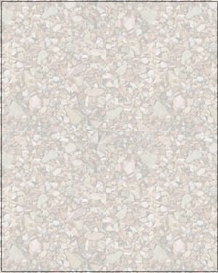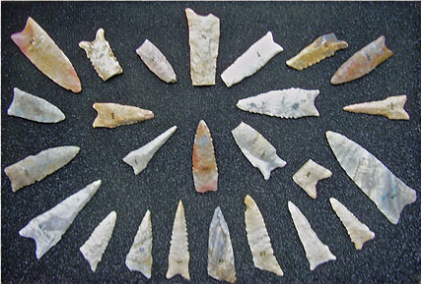
MAYBE FOOD FOR THOUGHT - - - - WHAT DO YOU THINK?
I have a hunter / collector friend who has spent well over 50 years putting together one of the best artifact collections in Western Missouri. He is a most interesting and knowledgeable person with virtually every piece of the thousands in his collection a personal find. We visit often and agree most of the time when discussing typology. Also, over the years, we have become aware that certain point types are more likely to be found on some sites or drainages than on others.
With the above having been said, we don't always agree on every topic we discuss. One of our disagreements revolves around the Dalton point. He maintains Dalton points vary to some extent as to basal configuration, basal thinning, fluting, grinding and sometimes style of flaking; and at this point, I am in agreement. Where we agree to sometimes disagree comes from his thinking that the large number of published Dalton variations and types make classification unnecessarily complicated, at least to a degree. Agreeably, information along with pictures and drawings is readily available concerning Holland, Nuckolls, Hemphill, Classic, Sloan, Colbert, and Breckenridge varieties, etc.
With the above having been said, we don't always agree on every topic we discuss. One of our disagreements revolves around the Dalton point. He maintains Dalton points vary to some extent as to basal configuration, basal thinning, fluting, grinding and sometimes style of flaking; and at this point, I am in agreement. Where we agree to sometimes disagree comes from his thinking that the large number of published Dalton variations and types make classification unnecessarily complicated, at least to a degree. Agreeably, information along with pictures and drawings is readily available concerning Holland, Nuckolls, Hemphill, Classic, Sloan, Colbert, and Breckenridge varieties, etc.


The Sedalia - West Central Missouri Archaeological Society, a chapter of the Missouri Archaeological Society, meets the fourth Saturday of every month (excluding January, November and December). Most meetings start at 7:00 PM and are held in the lower level of the Farm Credit Services building at 2600 S Limit Ave, Sedalia, MO, 65301. We have an annual artifact show.


Picture & Story by Larry DesCombes
Frame of Dalton and Dalton related artifacts showing some differences in configuration, particulary basal shapes.
Frame of Dalton and Dalton related artifacts showing some differences in configuration, particulary basal shapes.
His premise is, "Yes they are somewhat different, but- - - - - ." By comparing personal finds from individual sites and drainages, he makes a fairly strong statement that different Dalton variations can and do show up, all within certain individual areas. His thinking indicates he sees no reason to believe that many Dalton points from a particular area could not have been made by the same person or culture, yet vary considerably in appearance. "Wouldn't there have been variances in each knapper's ability and style and material used?" Further he says, "I don't think late or transitional paleo people were much different than people of today, in that they surely placed a value on individualism. Don't you think the ego could have been massaged a bit when one late paleo knapper produced a slightly different tool from that of his peer, with it being just as functional as the example his peer was expecting him to duplicate?"
He goes on to say that some knappers would have been more skilled than others and "Variations in basal shapes can possibly be explained by considering how the tool was to have been used. Into or onto what material was it to have been hafted? Was it to have been attached to bone or different varieties of wood? Would it have been used for hafting onto a handle and used for butchering or used on a longer shaft where it could have been easily left inside a carcass with the hunter being able to retrieve his favorite spear shaft? He further states, "I believe this Dalton variation thing may have been carried out too far. So, at this time, and to me, A Dalton is a Dalton, is a Dalton." I believe my friend to most likely be both right and wrong. Yes, a Dalton is a Dalton; but we may need to consider another thought or two.
At this point, it may be fair to ask ourselves if all Dalton peoples shared a common cultural kinship that went beyond the adoption and use of similar tool types. Wouldn't it be unwise to assume that all Dalton peoples, regardless of their location and time period, were of the same culture, whatever it might have been, prior to becoming what we refer to as Dalton peoples. Surely they weren't. Wouldn't it be more correct to refer to these peoples as being members of Dalton "cultures" as opposed to a single Dalton "culture"? Are we incorrect if we think that what we collectively call a Dalton group may have shared very little in common with other Dalton groups in the way they lived, except that each geographically located group became participants in the evolvement of tools we commonly refer to as Dalton points and blades? What other commonalities are we sure they would have shared other than Dalton type tools and the will to improvise and exist?
To perhaps further justify my thoughts on similarities and dissimilarities between differently located Dalton groups, I would add the following. Natural boundaries would sometimes have totally inhibited or at least slowed down the exchange of ideas between groups, with rivers and mountains being prime examples. Could religious beliefs have also altered or hindered the flow of ideas from one location to another? Should we not consider available food types in some areas as a possible reason for tool type variations? Could not the tool kits of cave and shelter dwellers have varied somewhat from those of peoples who fashioned their dwellings from natural vegetation? And when we consider shelter construction, would not different types of natural vegetation in different geographical areas have dictated the necessity for variations in the same basic tool types?
The study of how and why prehistoric man may have adopted some tool ideas and rejected others presents many unanswered and perhaps unanswerable questions. Certainly, some ideas would have traveled faster in some directions than others for a number of reasons.
I personally believe most of us may tend to be too generic when we refer to the Dalton culture or groups, or shouldn't we say "Dalton cultures"? I've found it difficult to think of a way to illustrate how different tool ideas may have traveled from one area to another where they may have been accepted, modified or rejected. Hopefully, the following will help the reader better understand my message.
Surely we have all stood at the edge of a lake or stream and thrown pebbles into the water, then watched as each concentric circle of wavelets travel away from each center. Imagine yourself as having thrown a number of individual pebbles over a period of a few seconds. Then look at one of the circles and imagine the center of it being yourself as a cultural group while imagining the other culture circles beginning at different times over hundreds and thousands of years. Next look at the other circles and notice how they have become larger and less well defined as they distance themselves from their centers. Imagine them as other cultures or groups geographically removed from your own group. By now we are seeing circles of wavelets beginning to overlap those made by other pebbles.
If we use the above example as an illustration, we must take into consideration that cultural ideas which would have brought change would not have ideally traveled in perfect circles from the point of origin because of barriers, whatever and wherever those may have been. As we watch each of those circles become larger and less pronounced, we can consider each (idea) to have had less impact as it made contact with another while others may have had greater impact. Maybe some of these traveling circles would have disappeared for lack of interest or purpose or the melding of one culture into another or influence from a culture at another location. Other wavelets making contact with certain other wavelets would illustrate other acceptances, modifications or rejections of ideas amongst other groups or cultures.
To take what I've discussed one step further, maybe we should first ask ourselves to define "the origin of a culture". I realize there had to be an "original culture" someplace and at sometime in the past; but for our purposes of thought, I personally feel cultures did not "originate". They would have had to have "evolved".
Regardless of how we interpret changes that occurred within the cultures of our earliest peoples, there is much to be learned and certainly even more we will never learn. However, I believe we can all agree that different ideas and concepts traveled at different rates, among different peoples, at different places, at different times, for different purposes or reasons.
Whether the reader agrees or disagrees with what I have presented is secondary to my hope that I may have created some food for thought. As for my friend, I'm still not sure how right or wrong he may be, but I heard him say again the other day, "A Dalton is still a Dalton, is still a Dalton- - - - - .".
Respectfully, Larry DesCombes
He goes on to say that some knappers would have been more skilled than others and "Variations in basal shapes can possibly be explained by considering how the tool was to have been used. Into or onto what material was it to have been hafted? Was it to have been attached to bone or different varieties of wood? Would it have been used for hafting onto a handle and used for butchering or used on a longer shaft where it could have been easily left inside a carcass with the hunter being able to retrieve his favorite spear shaft? He further states, "I believe this Dalton variation thing may have been carried out too far. So, at this time, and to me, A Dalton is a Dalton, is a Dalton." I believe my friend to most likely be both right and wrong. Yes, a Dalton is a Dalton; but we may need to consider another thought or two.
At this point, it may be fair to ask ourselves if all Dalton peoples shared a common cultural kinship that went beyond the adoption and use of similar tool types. Wouldn't it be unwise to assume that all Dalton peoples, regardless of their location and time period, were of the same culture, whatever it might have been, prior to becoming what we refer to as Dalton peoples. Surely they weren't. Wouldn't it be more correct to refer to these peoples as being members of Dalton "cultures" as opposed to a single Dalton "culture"? Are we incorrect if we think that what we collectively call a Dalton group may have shared very little in common with other Dalton groups in the way they lived, except that each geographically located group became participants in the evolvement of tools we commonly refer to as Dalton points and blades? What other commonalities are we sure they would have shared other than Dalton type tools and the will to improvise and exist?
To perhaps further justify my thoughts on similarities and dissimilarities between differently located Dalton groups, I would add the following. Natural boundaries would sometimes have totally inhibited or at least slowed down the exchange of ideas between groups, with rivers and mountains being prime examples. Could religious beliefs have also altered or hindered the flow of ideas from one location to another? Should we not consider available food types in some areas as a possible reason for tool type variations? Could not the tool kits of cave and shelter dwellers have varied somewhat from those of peoples who fashioned their dwellings from natural vegetation? And when we consider shelter construction, would not different types of natural vegetation in different geographical areas have dictated the necessity for variations in the same basic tool types?
The study of how and why prehistoric man may have adopted some tool ideas and rejected others presents many unanswered and perhaps unanswerable questions. Certainly, some ideas would have traveled faster in some directions than others for a number of reasons.
I personally believe most of us may tend to be too generic when we refer to the Dalton culture or groups, or shouldn't we say "Dalton cultures"? I've found it difficult to think of a way to illustrate how different tool ideas may have traveled from one area to another where they may have been accepted, modified or rejected. Hopefully, the following will help the reader better understand my message.
Surely we have all stood at the edge of a lake or stream and thrown pebbles into the water, then watched as each concentric circle of wavelets travel away from each center. Imagine yourself as having thrown a number of individual pebbles over a period of a few seconds. Then look at one of the circles and imagine the center of it being yourself as a cultural group while imagining the other culture circles beginning at different times over hundreds and thousands of years. Next look at the other circles and notice how they have become larger and less well defined as they distance themselves from their centers. Imagine them as other cultures or groups geographically removed from your own group. By now we are seeing circles of wavelets beginning to overlap those made by other pebbles.
If we use the above example as an illustration, we must take into consideration that cultural ideas which would have brought change would not have ideally traveled in perfect circles from the point of origin because of barriers, whatever and wherever those may have been. As we watch each of those circles become larger and less pronounced, we can consider each (idea) to have had less impact as it made contact with another while others may have had greater impact. Maybe some of these traveling circles would have disappeared for lack of interest or purpose or the melding of one culture into another or influence from a culture at another location. Other wavelets making contact with certain other wavelets would illustrate other acceptances, modifications or rejections of ideas amongst other groups or cultures.
To take what I've discussed one step further, maybe we should first ask ourselves to define "the origin of a culture". I realize there had to be an "original culture" someplace and at sometime in the past; but for our purposes of thought, I personally feel cultures did not "originate". They would have had to have "evolved".
Regardless of how we interpret changes that occurred within the cultures of our earliest peoples, there is much to be learned and certainly even more we will never learn. However, I believe we can all agree that different ideas and concepts traveled at different rates, among different peoples, at different places, at different times, for different purposes or reasons.
Whether the reader agrees or disagrees with what I have presented is secondary to my hope that I may have created some food for thought. As for my friend, I'm still not sure how right or wrong he may be, but I heard him say again the other day, "A Dalton is still a Dalton, is still a Dalton- - - - - .".
Respectfully, Larry DesCombes





















